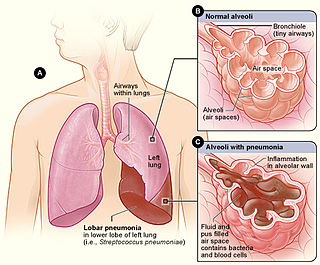
Lisch nodule, also known as iris hamartoma, is a pigmented hamartomatous nodular aggregate of dendritic melanocytes affecting the iris, named after Austrian ophthalmologist Karl Lisch (1907–1999), who first recognized them in 1937.

A lymphoblast is a modified naive lymphocyte with altered cell morphology. It occurs when the lymphocyte is activated by an antigen and increased in volume by nucleus and cytoplasm growth as well as new mRNA and protein synthesis. The lymphoblast then starts dividing two to four times every 24 hours for three to five days, with a single lymphoblast making approximately 1000 clones of its original naive lymphocyte, with each clone sharing the originally unique antigen specificity. Finally the dividing cells differentiate into effector cells, known as plasma cells, cytotoxic T cells, and helper T cells.

A fatty streak is the first grossly visible lesion in the development of atherosclerosis. It appears as an irregular yellow-white discoloration on the luminal surface of an artery. It consists of aggregates of foam cells, which are lipoprotein-loaded macrophages, located in the intima, the innermost layer of the artery, beneath the endothelial cells that layer the lumina through which blood flows. Fatty streaks may also include T cells, aggregated platelets, and smooth muscle cells. Although fatty streaks can develop into atheromas, not all are destined to become advanced lesions.

Erythema induratum is a panniculitis on the calves. It occurs mainly in women, but it is very rare now. Historically, when it has occurred, it has often been concomitant with cutaneous tuberculosis, and it was formerly thought to be always a reaction to the TB bacteria. It is now considered a panniculitis that is not associated with just a single defined pathogen. The medical eponym Bazin disease was historically synonymous, but it applies only to the tuberculous form and is dated.
Warm antibody autoimmune hemolytic anemia (WAIHA) is the most common form of autoimmune haemolytic anemia. About half of the cases are of unknown cause, with the other half attributable to a predisposing condition or medications being taken. Contrary to cold autoimmune hemolytic anemia which happens in cold temperature (28–31 °C), WAIHA happens at body temperature.

Hemosiderin or haemosiderin is an iron-storage complex that is composed of partially digested ferritin and lysosomes. The breakdown of heme gives rise to biliverdin and iron. The body then traps the released iron and stores it as hemosiderin in tissues. Hemosiderin is also generated from the abnormal metabolic pathway of ferritin.

Lobar pneumonia is a form of pneumonia characterized by inflammatory exudate within the intra-alveolar space resulting in consolidation that affects a large and continuous area of the lobe of a lung.
Heinz bodies are inclusions within red blood cells composed of denatured hemoglobin. They are not visible with routine blood staining techniques, but can be seen with supravital staining. The presence of Heinz bodies represents damage to hemoglobin and is classically observed in G6PD deficiency, a genetic disorder that causes hemolytic anemia. In veterinary medicine, Heinz bodies may be seen following the consumption of foods containing thiosulfate and propylene glycol compounds by cats, dogs and certain primates.

A thyroid adenoma is a benign tumor of the thyroid gland, that may be inactive or active as a toxic adenoma.

In pathology, Anitschkowcells are often cells associated with rheumatic heart disease. Anitschkow cells are enlarged macrophages found within granulomas associated with the disease.
Obstructive uropathy is a structural or functional hindrance of normal urine flow, sometimes leading to renal dysfunction.
Dyskeratosis is abnormal keratinization occurring prematurely within individual cells or groups of cells below the stratum granulosum.
Sulfatidosis is a form of lysosomal storage disease resulting in a proliferation of sulfatide.

Fat necrosis is a form of necrosis that is caused by the action of lipases on adipocytes.
Hereditary persistence of fetal hemoglobin (HPFH) is a benign condition in which increased fetal hemoglobin production continues well into adulthood, disregarding the normal shutoff point after which only adult-type hemoglobin should be produced.

Spermatocytic tumor, previously called spermatocytic seminoma, is a neoplasm of the testis, and classified as a germ cell tumour.
CFU-Meg is a colony forming unit. Haematopoiesis in the bone marrow starts off from a haematopoietic stem cell (HSC) and this can differentiate into the myeloid and lymphoid cell lineages. In order to eventually produce a megakaryocyte, the haematopoietic stem cell must generate myeloid cells, so it becomes a common myeloid progenitor, CFU-GEMM. This in turn develops into CFU-Meg, which is the colony forming unit that leads to the production of megakaryocytes.
CFU-Eo is a colony forming unit that gives rise to eosinophils. Some sources prefer the term "CFU-Eos". It is also known as "hEoP".
Nonthrombocytopenic purpura is a type of purpura not associated with thrombocytopenia.

Elliptocytes, also known as ovalocytes or cigar cells, are abnormally shaped red blood cells that appear oval or elongated, from slightly egg-shaped to rod or pencil forms. They have normal central pallor with the hemoglobin appearing concentrated at the ends of the elongated cells when viewed through a light microscope. The ends of the cells are blunt and not sharp like sickle cells.











